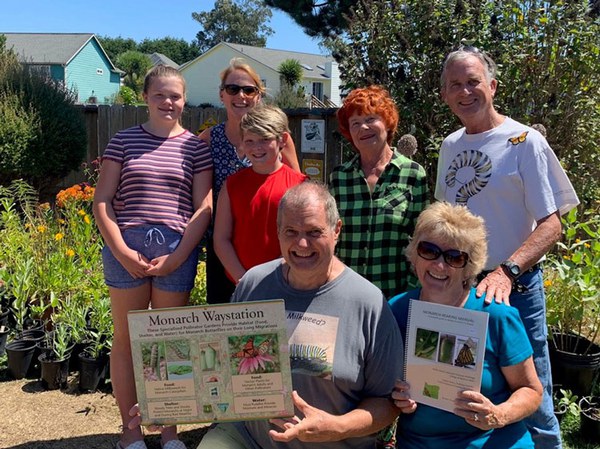The Deschutes Land Trust has recently gotten involved with an incredible event occurring in Brookings, Oregon this summer. And it all has to do with monarch butterflies!
Let’s start at the beginning. Back in early July, a female monarch flew into Holly’s pollinator garden in Brookings and laid a few eggs. This was great! Holly watched the butterfly lay 50 eggs that day, then tagged her. The monarch returned the next day and laid another 50 eggs. And the next day. And the next. Since monarchs typically lay around 300-400 eggs, this was quite unusual! In the end, this female monarch laid a staggering 588 eggs! Holly and others (including the Land Trust’s Amanda Egertson) responsibly raised the monarchs’ eggs to adults, tagged them, and released them.
But what to do? There are more eggs (that will turn into caterpillars to feed) than there is milkweed to eat! With the assistance of the Brookings Oregon Monarch Advocates (BOMA), monarch enthusiasts helped raise many of the eggs and caterpillars safely and responsibly. But the number of eggs continued to grow. BOMA partnered with other organizations like the Deschutes Land Trust, Southern Oregon Monarch Advocates, and Monarch Advocates of Central Oregon. A plan was made to collectively orchestrate a safe, healthy, and documented rearing program taking place in Brookings, the Rogue Valley, and Bend.
With the assistance and guidance of Dr. David James at Washington State University and Dr. Chip Taylor, the founder of Monarch Watch, those involved are using responsible rearing methods, collecting data, tagging all of the adult monarchs, and testing for the OE parasite.
OE stands for Ophryocystis elektroscirrha. It is a parasite that infects monarchs, who then have thousands of OE spores on their bodies. When they land on milkweed, they leave some of these spores on the leaves. Monarch caterpillars then eat the leaves that are covered in these OE spores and get infected. Depending on the degree of OE infection, monarchs can become too weak to expand their wings when they emerge from their chrysalis, live shorter lives, and cannot fly as well as healthy monarchs.
The amount of eggs being laid in Brookings is unprecedented. If you take into account that last year’s winter count for Western monarchs was less than 25,000 and there’s a chance this whole project could release 1,000-2,000 monarchs this year, it could have a noticeable impact on the Western monarch’s population. This current generation of caterpillars will be the butterflies that migrate south to overwinter in California.
Currently, the Land Trust is in the process of responsibly rearing around 40-50 monarchs who are happily chomping away at fresh milkweed. We hope you’ll follow along on this incredible journey via Facebook and Instagram!
A huge thank you to Robert Coffan at Southern Oregon Monarch Advocates for supplying the information for this blog post!
Learn more:


